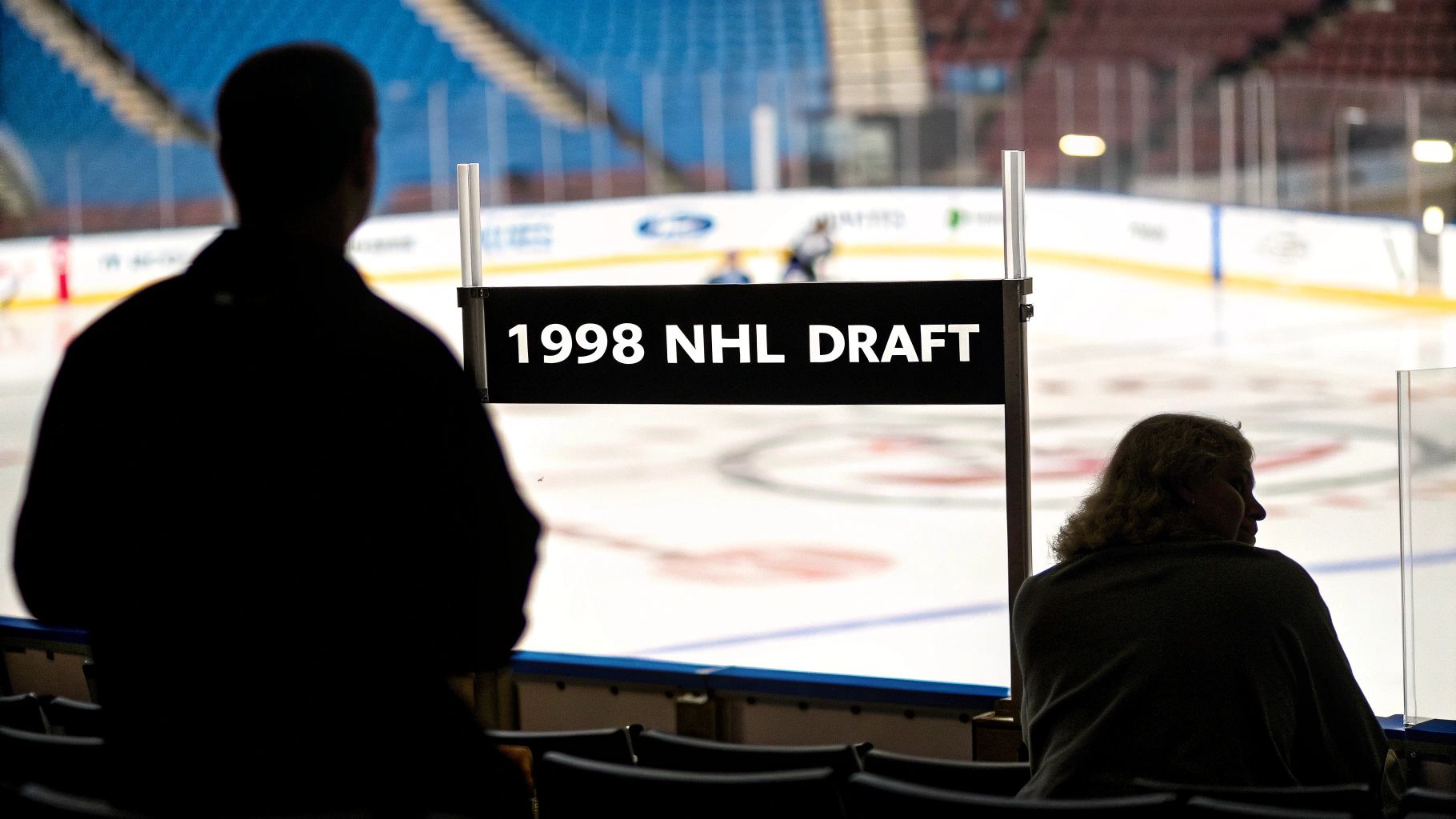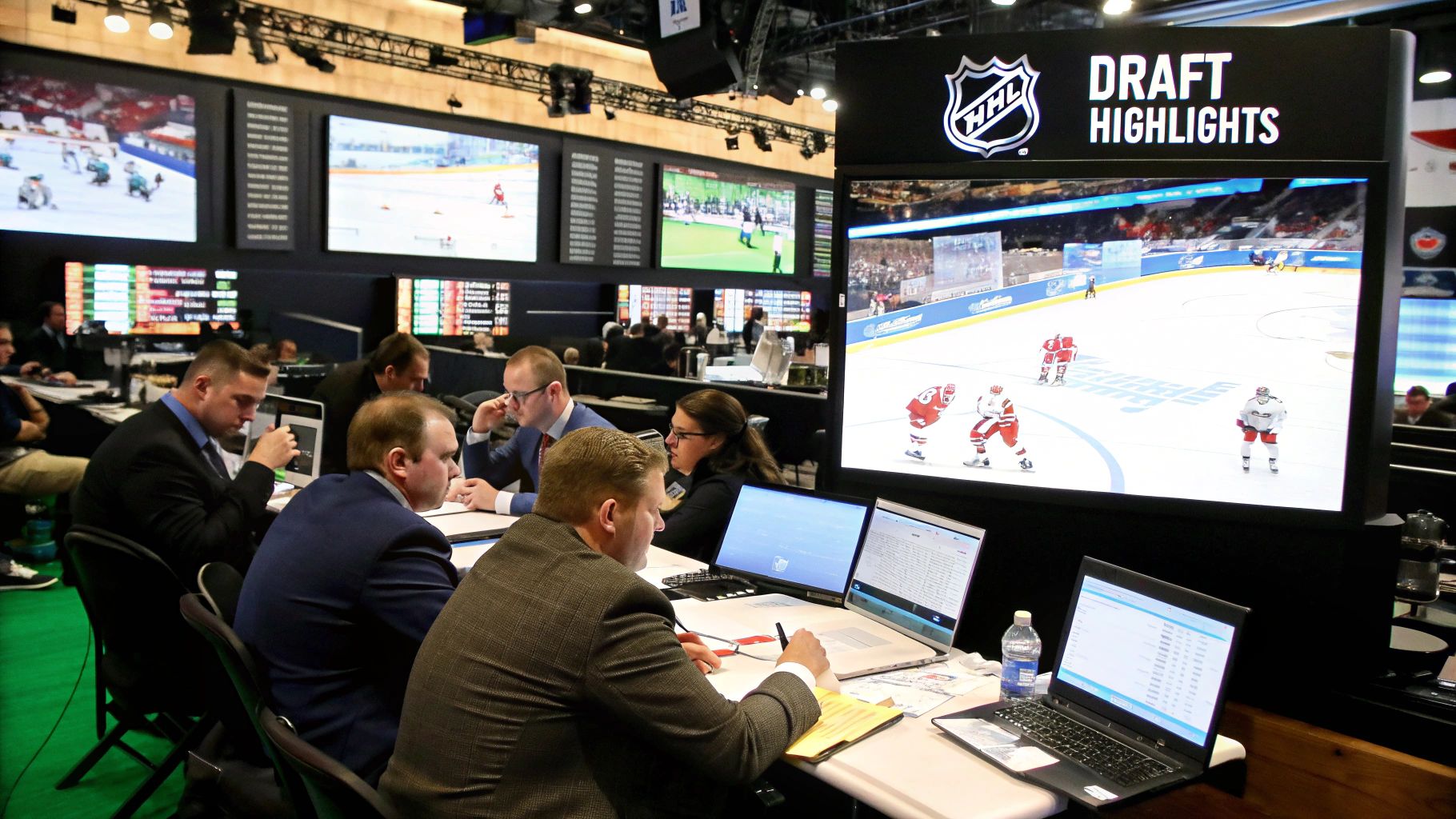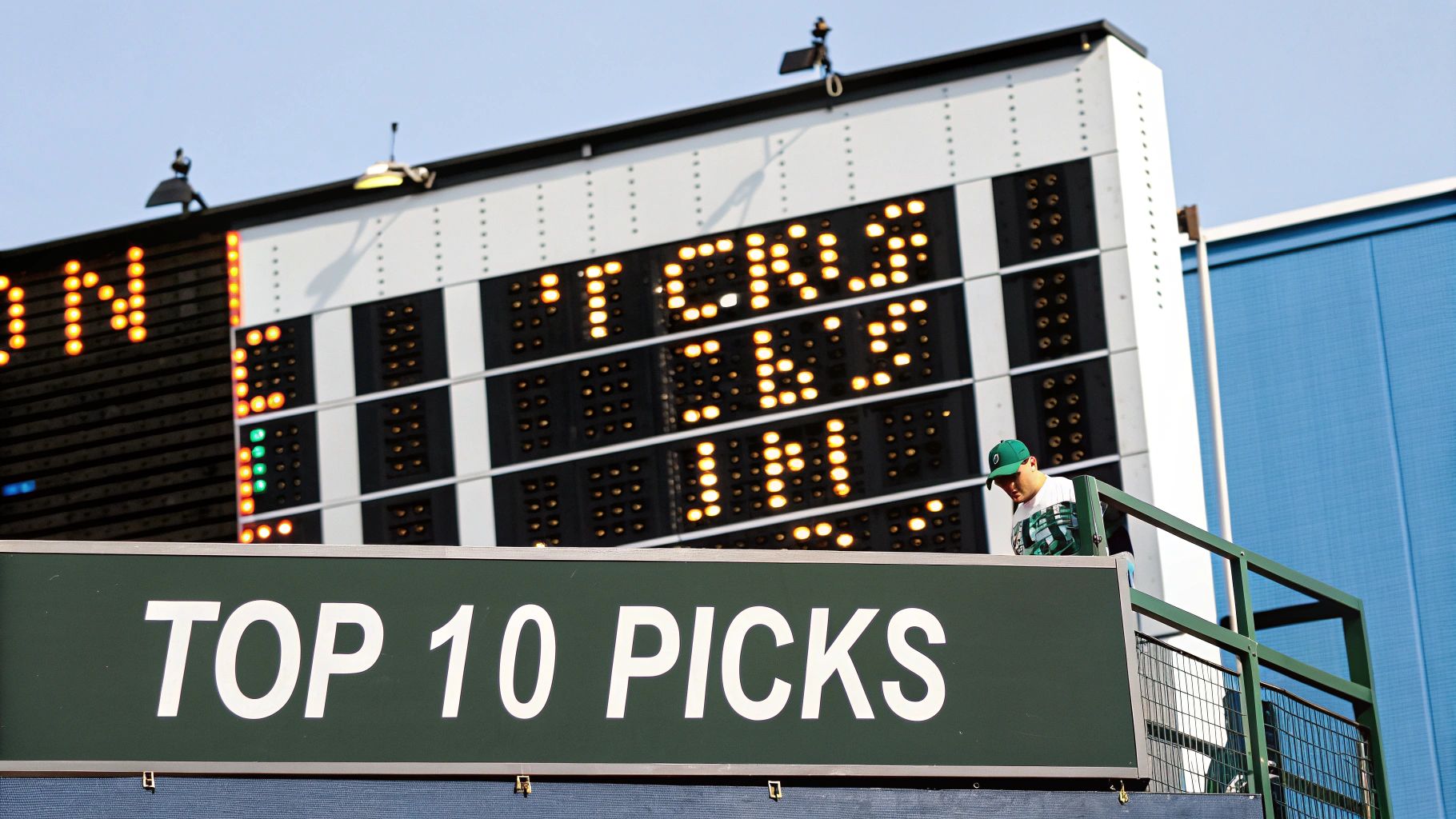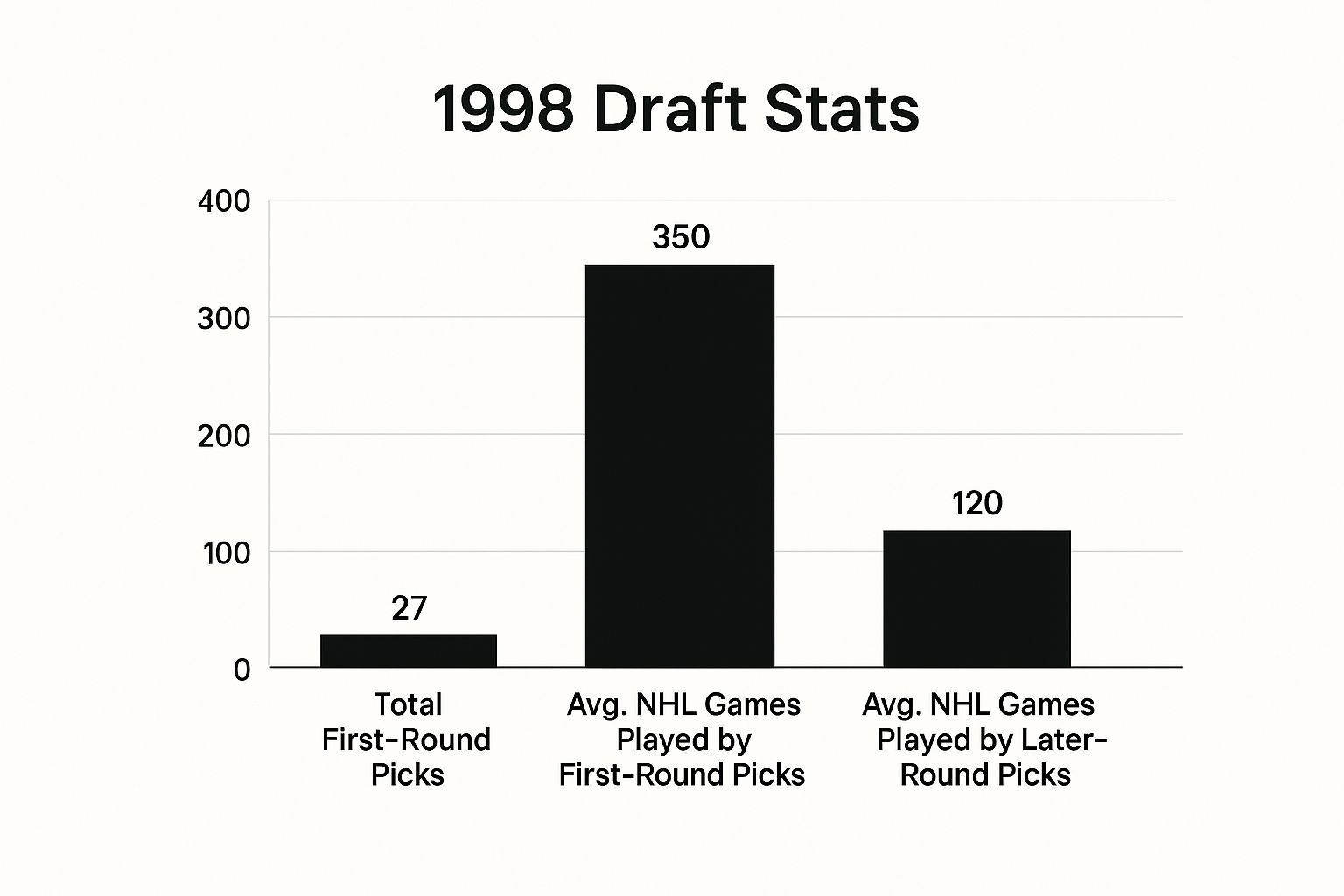NHL Entry Draft 1998: Top Picks & Hidden Gems Revealed

The 1998 NHL Entry Draft wasn't just another draft; it was a moment that would shape the fortunes of several franchises for years to come. The Tampa Bay Lightning snagged Vincent Lecavalier with the first overall pick, and the brand-new Nashville Predators made their inaugural selection, officially stamping their entry into the league.
Held in Buffalo, New York, this draft class is remembered for its blend of sure-fire top talent and some absolutely incredible late-round gems.
Setting the Stage in Buffalo
The air inside Buffalo's Marine Midland Arena on June 27, 1998, was electric. For teams that had struggled all season, the draft was more than just a meeting—it was a lifeline. A single pick had the power to change a team's entire trajectory for the next decade.

No team felt that pressure more than the Tampa Bay Lightning. Coming off a brutal season with only 17 wins, they held the coveted first overall selection. The weight of that choice was immense; they desperately needed a cornerstone player to build around. You can get a better sense of the pressure and process if you're curious about how the NHL draft lottery works.
Adding to the excitement was the arrival of the Nashville Predators. As an expansion team, their first-ever draft pick was a foundational moment. It wasn’t just about adding a player; it was about laying the very first brick for their new identity. That made their second overall pick one of the most-watched moments of the entire event.
The Key Narratives
Beyond the top two spots, the buzz around the 1998 draft centred on its depth. Scouts and analysts were convinced that this class, especially the talent coming out of the Canadian junior leagues, was loaded. The consensus was clear: while there were obvious stars at the top, real value was waiting to be discovered in the later rounds.
That belief turned out to be spot on. Some of the era's most iconic players were still sitting in their seats, waiting for their names to be called.
The draft ultimately saw 258 players selected. In a true sign of this class's quality, the top three picks—Vincent Lecavalier, David Legwand, and Brad Stuart—each went on to play over 1,000 NHL games.
Lecavalier's career became a benchmark for what a first-overall pick could achieve. He put up 949 points, won the Rocket Richard Trophy in 2006-07, and eventually lifted the Stanley Cup. His journey from that draft stage in Buffalo to becoming a champion perfectly captured the kind of game-changing potential that every team hopes to find.
Top 5 Selections of the 1998 NHL Draft
The top of the 1998 draft board was stacked with talent destined for long, productive NHL careers. Here’s a quick look at the first five players who heard their names called in Buffalo.
| Pick # | Player Name | Drafted By | Position |
|---|---|---|---|
| 1 | Vincent Lecavalier | Tampa Bay Lightning | C |
| 2 | David Legwand | Nashville Predators | C |
| 3 | Brad Stuart | San Jose Sharks | D |
| 4 | Bryan Allen | Vancouver Canucks | D |
| 5 | Vitali Vishnevski | Mighty Ducks of Anaheim | D |
As you can see, the early picks were a mix of high-scoring centres and steady, franchise-altering defencemen. This top tier set the tone for a draft class that would leave a lasting mark on the league for more than a decade.
The Legacies of the Top Draft Picks
You can often judge a draft class by how its top picks pan out. For the 1998 NHL Entry Draft, the top three selections didn't just meet the hype—they went on to define their franchises for more than a decade. Vincent Lecavalier, David Legwand, and Brad Stuart became cornerstones, though each carved out a very different path.

These guys weren't just skilled players; they were foundational pieces who shouldered the massive weight that comes with being a top draft choice.
Vincent Lecavalier: The Franchise Saviour
When the Tampa Bay Lightning took Vincent Lecavalier first overall, he was immediately handed the keys to the franchise. He delivered. "Vinny" grew into one of the most dominant power forwards of his generation, bringing a blend of size, skill, and scoring punch that the struggling Lightning desperately needed.
His career was packed with elite performances. He hit the absolute peak in 2004, leading Tampa Bay to its first-ever Stanley Cup. His personal trophy case wasn't too shabby, either—in the 2006-07 season, he potted a league-best 52 goals to win the Maurice "Rocket" Richard Trophy. Over 1,212 games, Lecavalier racked up 949 points and cemented his place as a true superstar.
David Legwand: Mr. Predator
The Nashville Predators picking David Legwand second overall was a historic moment. He wasn't just their first pick in the draft; he was their first player, period. Legwand became the original Predator, the face of a new franchise trying to make its mark on the league.
His legacy is stitched right into the fabric of the organization. He still holds several franchise records, including most games played, and was a picture of consistency for 15 seasons in Nashville. While he never put up the eye-popping numbers Lecavalier did, his value as a reliable, two-way centre was off the charts. He was the steady hand that guided the Predators through their early years.
The top of the 1998 draft delivered remarkable longevity. Lecavalier, Legwand, and third-overall pick Brad Stuart all surpassed the 1,000-game milestone, a rare feat that underscores the quality of scouting at the top of the board.
Brad Stuart: The Dependable Blueliner
Drafted third by the San Jose Sharks, Brad Stuart quickly made a name for himself as a premier shutdown defenceman. His game was never flashy, but it was incredibly effective. Stuart was exactly the kind of player every contender needs: a tough, steady defender who could eat up heavy minutes against the other team's top lines.
He played for a few different teams over his career, but his impact was the same everywhere he went. He was a key part of the Detroit Red Wings team that hoisted the Stanley Cup in 2008, providing the grit and defensive backbone that complemented their high-flying offence. Stuart’s long and successful career is a perfect example of how a top pick can define a team's defensive identity, much like the pillars we saw in other classes, like the retrospective on the 1993 NHL draft.
The Canadian Junior Hockey Pipeline

You can't talk about the nhl entry draft 1998 without starting in Canada. For decades, the road to the NHL was paved through the Canadian junior leagues, and '98 was the perfect example of that system firing on all cylinders. It was a well-oiled machine designed to turn promising teenagers into pros.
The Canadian Hockey League (CHL) was—and still is—the ultimate crucible for NHL hopefuls. It’s split into three distinct leagues, each with its own flavour and reputation for churning out specific types of talent.
- The Ontario Hockey League (OHL): This was the league for skill and offence. If you were looking for a future goal-scorer or power-play quarterback, the OHL was your first stop.
- The Western Hockey League (WHL): Known for its punishing travel schedules and hard-nosed style, the WHL produced players who were tough, resilient, and ready for the grind of a professional season.
- The Quebec Major Junior Hockey League (QMJHL): Celebrated for its creativity and blistering pace, the "Q" was where you'd find the next great playmaker.
Back in 1998, NHL scouts were practically living in the rinks of cities like Red Deer, Sarnia, and Halifax. They weren't just clocking goals and assists; they were watching how these kids handled the pressure, how they led their teams, and whether they could withstand a long, gruelling season.
The Proven Path to the Pros
Putting up big numbers in one of these leagues was almost a non-negotiable for getting drafted high. It was the clearest signal an 18-year-old could send to an NHL front office: "I'm ready for the next level." This pipeline was the foundation of talent evaluation for an entire generation.
The proof is in the pudding. Just look at how many players from the OHL, WHL, and QMJHL went on to have long, impactful NHL careers. A prime example is Brad Richards, plucked 64th overall from the QMJHL's Rimouski Oceanic. He went on to play 1,126 NHL games, racking up 298 goals and 634 assists. That's the kind of value hiding in the Canadian junior system. You can see how a modern take might shake things up by re-drafting the 1998 class.
This reliance on the CHL wasn't just a coincidence; it was a core scouting strategy. Teams knew that players coming out of these leagues were already conditioned for the pro lifestyle, having balanced a demanding hockey schedule with school and the spotlight of being a local star.
Why This System Worked
The success of the Canadian junior pipeline was no accident. The whole structure was built to mimic the pro experience, giving these players a serious head start.
This model allowed prospects to grow up fast, both on and off the ice. They learned how to deal with media scrums, team responsibilities, and the weight of expectations. So when their name was called at the nhl entry draft 1998, they weren't just talented kids. They were seasoned competitors, ready for the challenge ahead—and they formed the backbone of a truly memorable draft class.
Uncovering the Biggest Draft Steals
Everyone pays attention to the first round, expecting those top picks to become stars. But the real magic of a great draft class often happens hours later, deep in the later rounds when only the die-hard fans and dedicated scouts are still watching. The nhl entry draft 1998 is legendary for this very reason—it wasn't just about the big names at the top, but about the incredible diamonds in the rough unearthed late in the day.
Finding a future superstar in the sixth or seventh round is the hockey equivalent of finding a winning lottery ticket. It’s a rare mix of sharp scouting, a bit of luck, and a player’s sheer will to prove everyone who passed on them wrong. The 1998 class gave us some of the best examples of this phenomenon in modern NHL history.
The Magic Man from the Sixth Round
When the Detroit Red Wings took a flier on a little-known Russian forward named Pavel Datsyuk with the 171st overall pick, it was a total non-event. No one batted an eye. Yet, that decision would go down as one of the greatest scouting heists of all time, as Datsyuk blossomed into the "Magic Man"—a player whose skill and creativity were so off the charts he regularly left opponents, and even his own teammates, completely mesmerized.
Datsyuk’s two-way game was practically flawless. He was an offensive wizard, piling up 918 points in 953 games, but his defensive instincts were just as elite. His ability to pickpocket unsuspecting forwards was the best in the league, earning him the Frank J. Selke Trophy as the NHL's top defensive forward for three straight seasons from 2008 to 2010. On top of that, he won the Lady Byng four times and, most importantly, two Stanley Cups with Detroit.
For a sixth-round pick to not just make the NHL but to become a franchise icon and a future Hall of Famer is almost unheard of. Datsyuk’s career is the ultimate testament to the value that can be found deep in the draft.
More Than Just One Gem
But Datsyuk wasn't the only late-round treasure discovered in 1998. The draft was littered with players picked outside the top rounds who went on to have exceptional careers, delivering an incredible return on investment for the teams that took a chance on them.
This infographic shows just how much of a long shot it is for later picks to build a sustained career, which makes the success stories from 1998 stand out even more.

The data really puts into perspective how rare these late-round hits are. A few other notable steals from this draft underscore its amazing depth:
- Andrei Markov (162nd overall): The Montreal Canadiens found their defensive cornerstone in the sixth round. Markov developed into an elite power-play quarterback and a steady leader on their blue line for 16 seasons, playing an incredible 990 games.
- Brad Richards (64th overall): While not quite as deep of a pick, grabbing Richards in the third round was a massive win. He won the Conn Smythe Trophy as playoff MVP in 2004 after leading the Tampa Bay Lightning to a Stanley Cup and added another ring with Chicago in 2015.
Below is a quick look at just how much value some of these players provided relative to where they were drafted.
Biggest Steals of the 1998 Draft
A comparative look at the draft's biggest steals, showing their draft position against their remarkable career achievements to highlight their incredible value.
| Player Name | Pick # | Career NHL Games | Career NHL Points |
|---|---|---|---|
| Pavel Datsyuk | 171 | 953 | 918 |
| Andrei Markov | 162 | 990 | 572 |
| Brad Richards | 64 | 1,126 | 932 |
| Jaroslav Špaček | 117 | 880 | 355 |
These careers aren't just good for late-rounders—they're fantastic for any draft pick. It goes to show that the nhl entry draft 1998 was defined by its incredible depth. Teams that did their homework were rewarded with franchise-altering talent long after the first-round frenzy was over.
The Enduring Statistical Impact
What really makes a draft class legendary? Big moments and highlight-reel careers are what we remember, but the true legacy of the nhl entry draft 1998 is written in the numbers. When you dig into the stats, you see a class with incredible depth and staying power that few others from that era can touch.
The data tells a story that goes way beyond just the big names at the top. This wasn't a draft carried by a few superstars; it was a group that consistently churned out quality NHL players from the first round to the last.
A Class Defined by Longevity
One of the best ways to judge a draft is to see how many players actually make it and, more importantly, stick around. The 1998 class was a monster in this regard. Of the 258 players picked, a staggering 51.2% played at least one NHL game. That’s about 132 guys who reached the show.
Even better, the ones who made it had real careers. The average player from this draft class suited up for 317 NHL games, a number that speaks volumes about their talent and durability. When you stack those stats up against the drafts immediately before and after, it’s clear the 1998 talent pool was exceptionally deep. You can see the full breakdown for every player over at HockeyDB.com.
The 1998 draft produced an unbelievable seven players who skated in over 1,000 NHL games. This elite club includes top picks like Vincent Lecavalier and David Legwand, but also later-round steals like Brad Richards and Andrei Markov.
Beyond Goals and Assists
While points are great, the real impact of this draft class shows up in the deeper metrics. These guys were play-drivers who consistently tilted the ice for their teams, contributing on both sides of the puck. If you look at their careers through a modern lens using stats that measure puck possession, their value becomes even clearer. You can get a better feel for this by checking out our guide on what Corsi is in hockey.
It's this blend of high-end production, incredible longevity, and all-around impact that cements the 1998 draft's place in hockey history.
- Top-Tier Talent Delivered: All three of the top picks became franchise players, and each played over 1,000 games.
- Mid-Round Success: Guys like Brad Richards (64th) turned into superstars, winning major awards and Stanley Cups.
- Late-Round Legends: Finding Pavel Datsyuk (171st) and Andrei Markov (162nd) in the sixth round was the kind of scouting home run that changes franchises.
At the end of the day, the statistical footprint of the nhl entry draft 1998 is impossible to ignore. It pumped high-quality NHL talent into the league at a rate that set it apart, leaving a mark that was felt for more than a decade.
Common Questions About the 1998 NHL Draft
Decades later, the 1998 NHL Entry Draft still gets hockey fans talking. It’s the perfect storm of elite superstars, late-round heists, and high-profile busts, making it a legendary case study in scouting and development.
To settle some of those classic debates, we’ve tackled the most common questions about the iconic ’98 class.
Who Would Go First Overall in a Redraft?
This is the ultimate armchair GM debate, and the conversation always circles back to one man: Pavel Datsyuk. Vincent Lecavalier was a fantastic player and a worthy first-overall pick, but Datsyuk was on another planet. He wasn't just skilled; he became one of the most dominant two-way forces of his era.
It’s hard to believe a player taken 171st overall could rack up this resume:
- Two Stanley Cups
- Three Frank J. Selke Trophies for best defensive forward
- Four Lady Byng Trophies for his incredible skill and sportsmanship
Datsyuk’s blend of magical offensive talent and lockdown defensive play makes him the hands-down consensus pick for number one in any 1998 redraft.
Was There a Major Bust in the First Round?
"Bust" is a tough label, since plenty of first-rounders carve out decent careers. But if you’re looking for the biggest disappointment from the top of the board, most people point to Vitali Vishnevski, taken fifth overall by the Mighty Ducks of Anaheim.
He was drafted to be a huge, punishing, shutdown defenceman—the kind of player you build a blue line around. While he did manage to play over 400 NHL games, he never became that franchise cornerstone. His offence was virtually non-existent (he scored just 16 goals his entire NHL career), and he lacked the game-breaking defensive impact you expect from a top-five pick.
What Was the Best Team Draft in 1998?
The Detroit Red Wings obviously hit the jackpot by unearthing Pavel Datsyuk in the sixth round, but another team quietly put together an outstanding draft that became its foundation. The New York Rangers made several smart picks that paid off massively.
Their 1998 haul included:
- Manny Malhotra (7th overall): Became a high-character, dependable centre who played nearly 1,000 NHL games.
- J以後an Wiemer (100th overall): A solid winger who was a useful contributor for years.
This brings us to the biggest question of all...
Who was the best player in the entire 1998 NHL Entry Draft class? Based on individual awards, team success, and sheer on-ice dominance, Pavel Datsyuk holds the strongest claim to that title. He was a true game-changer in every sense of the word.
Why Is This Draft Class Considered So Deep?
The 1998 NHL Entry Draft absolutely earned its reputation for being loaded with talent. It’s not just about the stars at the top; the sheer number of players who went on to have long, productive careers is what sets it apart. An incredible seven players from this class played over 1,000 NHL games.
Look past the household names and you’ll find guys like Mike Ribeiro (45th), Simon Gagné (22nd), and Jaroslav Špaček (117th), who all became vital pieces for their teams. That consistent flow of talent from the first round to the last is why the '98 draft is still considered one of the greatest ever.
At PuckNStick, we live for digging into the stats and stories that make hockey great. For more deep dives and detailed player analytics, check out our full suite of tools.
